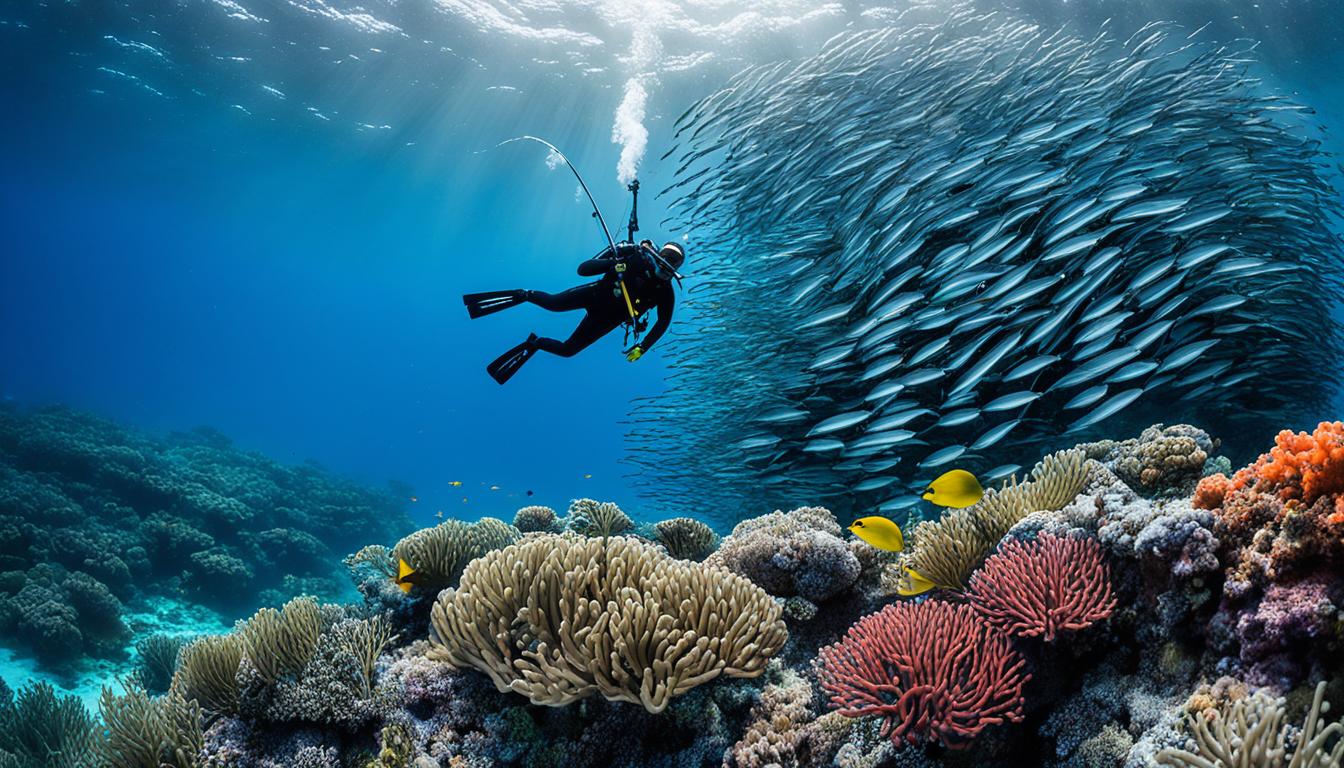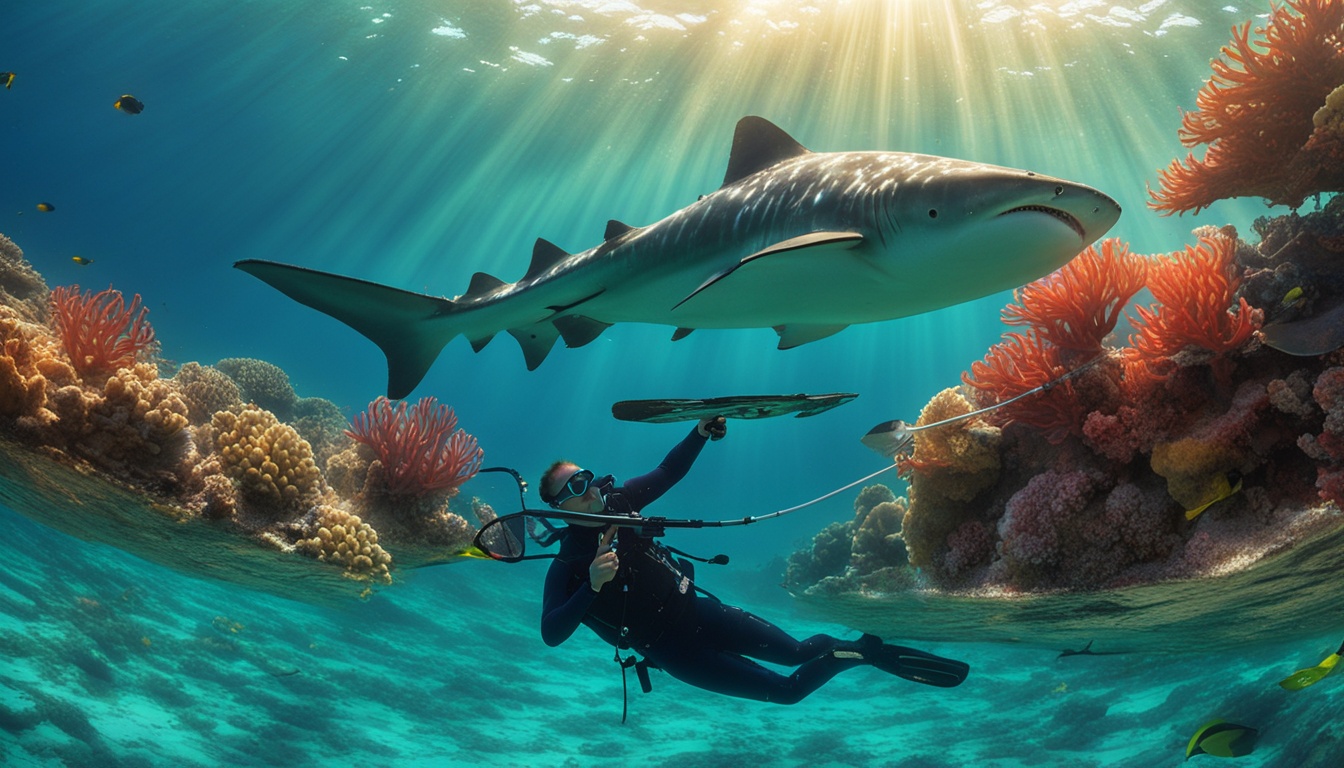Imagine diving into the crystal-clear waters, surrounded by marine life, as you embark on an underwater adventure. Spearfishing, the exhilarating sport of hunting fish underwater, requires skill, patience, and a deep understanding of the ocean ecosystem. And when it comes to mastering the art of spearfishing, one name stands out: Tim McDonald.
Tim McDonald is not just an experienced spearfisherman but also a renowned expert in the field. As the current Australian Spearfishing Champion alongside Bryson Sheehy, Tim has honed his skills over 15 years of dedicated diving. He has explored the depths of the oceans, learning the behavior and habitats of various marine species.
But Tim’s expertise goes beyond his championship titles. He has shared his knowledge and insights with the spearfishing community through interviews, podcasts, and blog posts. His tips on hunting specific species like Barramundi, Pearl Perch, and Green Jobfish have proven invaluable to spearos looking to improve their success rate.
Tim’s passion for spearfishing extends to conservation efforts as well. He advocates for sustainable hunting practices, ensuring future generations can also enjoy the wonders of the underwater world. With his guidance, spearos can learn not only how to hunt but also how to protect and preserve the delicate marine ecosystems.
Key Takeaways:
- Tim McDonald is a spearfishing expert with years of experience and multiple championship titles.
- He shares valuable tips on hunting specific species like Barramundi, Pearl Perch, and Green Jobfish.
- Tim emphasizes sustainable hunting practices to protect marine ecosystems for future generations.
- His knowledge and insights have benefited spearos looking to improve their success in the sport.
- Through his expertise, Tim McDonald has become a trusted source in the spearfishing community.
Targeting Specific Species in Spearfishing
When it comes to spearfishing, targeting specific species can be a thrilling challenge. The key to success lies in knowledge, preparation, and the right techniques. Spearfishing expert Tim McDonald has extensive experience in hunting various species, and he generously shares his expertise through podcasts and blog posts.
McDonald’s valuable insights cover a wide range of species. From hunting deep reef fish to targeting mulloway, barramundi, and more, his tips and techniques can greatly improve your success rate when it comes to spearing your desired catch.
Through McDonald’s podcasts, you can dive deep into the world of spearfishing and gain valuable knowledge about the behavior, habitats, and techniques required for targeting specific species. With a total of 9 episodes dedicated to this topic, you’ll find a wealth of information to enhance your spearfishing adventures.
“When you’re targeting specific species in spearfishing, it’s essential to understand their habits and tendencies. By combining knowledge, patience, and the right approach, you can significantly increase your chances of success.” – Tim McDonald
Whether you’re interested in hunting snapper, white mussel cracker, green jobfish, ling cod, or any other species, McDonald’s tips and insights can help you refine your hunting skills and improve your overall spearfishing experience.
To give you an idea of the breadth of species covered, here are some notable examples: deep reef fish, mulloway, barramundi, striped bass, pelagic species such as wahoo, dogtooth tuna, and yellowfin tuna, blackspot tuskfish, and more. With such a diverse range of species discussed, you’ll find valuable information to target the fish you’re after.
McDonald’s expertise and passion for spearfishing shine through in every episode. Through his insight, you’ll gain a better understanding of the unique challenges each species presents and the techniques required to overcome them.
So, if you’re looking to elevate your spearfishing game and target specific species with precision, be sure to tune in to Tim McDonald’s podcasts and explore his blog posts. You’ll discover a wealth of spearfishing tips and techniques that can help you become a more skilled and successful hunter in the underwater world.
Spearfishing California – Ling Cod
When it comes to spearfishing in Northern California, one of the primary targets for both line anglers and spear fishermen is the impressive ling cod (Ophiodon elongatus). This popular species is known for its size, great eating qualities, and challenging nature. Spearfishing ling cod has become a favorite activity among underwater hunters in this region.
Jim Russell, a renowned spearfisherman and Monkey Face Prickle Back state record holder in Northern California, suggests that ling cod can be forgiving once spotted and generally won’t make a frantic escape right away. This makes them an ideal target for spearos looking for an exciting hunting experience.
Ling cod prefer to hide in rock crevices and caves, strategically avoiding seals and other predators. They are often found in smaller, tighter caves, making “hole hunting” an effective method for spearos to spot them. This technique involves focusing on rock crevasses and caves that face away from swell directions.
“The key to successful ling cod hunting lies in finding those productive reef areas,” says Jim Russell.
Indeed, finding the right locations is crucial for a successful spearfishing trip. Northern California offers both shallow and deep waters where ling cod can be found. However, it’s important to note that diving conditions in this area can vary, with thick kelp stands during the summer months that may obstruct visibility. The good news is that winter swells often clear up the water, providing better hunting conditions.
When gearing up for a ling cod spearfishing adventure, short guns (65cm – 75cm) are preferred due to close quarters and poor visibility. Additionally, it’s essential to wear a good quality 7mm wetsuit to combat the cold water temperatures in Northern California.
To summarize, spearfishing ling cod in California offers an exciting challenge for underwater hunters. With the knowledge shared by experts like Jim Russell and a focus on finding the right reef areas, spearos can enhance their chances of encountering and successfully spearing these impressive fish.
| Location | Angling Record (lbs) | Year |
|---|---|---|
| Mendocino | 37 | 2012 |
| Del Norte | 56 | 1992 |
Spearfishing Green Jobfish
Green jobfish, also known as green dogtooth tuna, are a challenging species to hunt, requiring a unique approach and understanding of their behavior. Tim McDonald, an experienced spearfisherman, has spent years targeting green jobfish in Southeast Queensland, where he has honed his skills and developed effective strategies. In an interview, Tim shared invaluable tips that can help spearos improve their success rate in hunting green jobfish.
One key insight that Tim mentioned is that green jobfish in Southeast Queensland exhibit different behavior compared to their Northern counterparts. Unlike their Northern counterparts, these jobfish do not eat burley. Instead, Tim found that hunting in Southeast Queensland involves hiding and lying on the bottom, using techniques that attract the curiosity of these elusive fish.
To attract green jobfish while lying on the bottom, spearos can employ techniques such as scratching coral, throwing up sand, and making noise with gloves. Noise is emphasized as crucial in hunting green jobfish, with the right sounds attracting them while the wrong noises, like bumping the gun on the bottom, can startle and scare them away.
Targeting Green Jobfish Techniques
In his interview, Tim emphasized the importance of observing and being adaptable during the hunting process. He mentioned that his success in spearfishing green jobfish, as well as other species like barramundi and pearl perch, is attributed to his willingness to make small changes and adapt his hunting strategies continually.
When it comes to finding green jobfish, Tim suggested exploring Southeast Queensland, where it is likely the southernmost extent of their species range on the East Coast of Australia. However, he also acknowledged that hunting in New South Wales can be more challenging and may require endurance and patience to stay hidden.
Overall, spearfishing green jobfish requires a combination of skill, knowledge, and adaptability. By understanding their behavior, employing effective techniques, and continuously learning from experienced spearos like Tim McDonald, hunters can increase their chances of encountering and successfully hunting these challenging and rewarding fish.

Note: The image above depicts the excitement and thrill of spearfishing for green jobfish in Southeast Queensland. The crystal-clear waters and vibrant marine life make spearfishing in this region an unforgettable experience. Enthusiasts from all over often compare their trips here to their spearfishing adventures in Newcastle, where similar breathtaking underwater terrains and prized catches lure in divers year-round. Both locations offer unique challenges and rewards for those seeking to test their skills beneath the waves.
Stay tuned for the upcoming sections of this article, where we will explore hunting other intriguing species in spearfishing, including pearl perch and barramundi.
Spearfishing Pearl Perch
Pearl perch, also known as Pearlies, are a prized target for spearos due to their elusive nature and delicious taste. Tim McDonald, a seasoned spearfisherman and the current Queensland and Australian Spearfishing Champion, has honed his skills in hunting pearl perch over his 20-year career. In an exclusive interview, Tim revealed his expert tips and techniques for successfully spearfishing pearl perch.
Tim McDonald’s Top 5 Tips for Spearfishing Pearl Perch
- Locate a School: Before entering the water, it’s crucial to find a school of pearl perch. Tim emphasizes the importance of using a sounder to identify the presence and location of these fish.
- Spot Selection: Contrary to popular belief, large structures are not necessary to find pearl perch. Tim recommends targeting smaller bommies or rubble patches where these fish are known to gather.
- Practice Sustainable Hunting: Tim follows an ethical approach to spearfishing pearl perch, practicing a method known as farming. He only takes a limited number of fish from his spots to prevent depleting the schools.
- Easy to Catch: According to Tim, pearl perch are forgiving and easily enticed with bait. They have a voracious appetite and tend to eat everything in their path, making them relatively easy to catch.
- Go Deep or Stay Shallow: When targeting pearl perch, Tim suggests adjusting your depth based on the region. In Queensland, where you go deeper, pearl perch are found at greater depths. In New South Wales, finding isolated areas in shallower waters can yield successful hunts.
By following Tim McDonald’s expert advice, spearos can increase their chances of encountering and successfully hunting pearl perch. These tips provide key insights into locating these elusive fish, choosing the right spots, practicing sustainability, and adjusting to the suitable depth for a successful hunting expedition.

| Tim McDonald’s Record-Breaking Achievements in Spearfishing | Weight |
|---|---|
| Large Mouth Nannygai | 13.57kg |
| Mangrove Jack | 14.3kg |
| Queensland Pearl Perch | 3.5kg (state record) |
| Jobfish | 12.7kg |
| Threadfin Salmon | 11.7kg |
Tim McDonald’s impressive record-breaking achievements in spearfishing highlight his mastery in the sport and serve as inspiration for aspiring spearos. His expertise in fish behavior, dedication to setting goals, and commitment to sharing knowledge make him a true ambassador for the spearfishing community.
Spearfishing Barramundi
Barramundi, one of Australia’s most sought-after species in spearfishing, presents a thrilling challenge for divers, especially in the waters of Queensland. Fortunately, Tim McDonald, a seasoned spearfisherman with 15 years of experience in the sport, has provided valuable insights into hunting barramundi.
As a Christian Pastor in the Western Suburbs of Brisbane, Tim McDonald exemplifies dedication and discipline both in his spiritual calling and his underwater pursuits. His passion for spearfishing extends not only to personal adventures but also to nurturing the sport in the younger generation. In fact, his son is currently breaking Queensland state junior spearfishing records, showcasing the family’s commitment to the sport.
Tim McDonald’s expertise is further amplified through his sponsorship with Riffe, a well-known brand in the spearfishing industry. This partnership speaks volumes about his skills and knowledge, as reputable companies only associate themselves with exceptional individuals in their field.
In a captivating interview, Tim McDonald covers a wide range of topics, sharing his memorable catches, thrilling adventures along the East Coast of the USA, favorite hunting techniques, scariest moments, and invaluable tips for targeting various species. Among these species, barramundi stands out as a challenging and elusive quarry.
When it comes to spearfishing barramundi, Tim McDonald emphasizes the significance of timing and location. Clean diving waters are essential for encountering this iconic species. By paying attention to weather patterns and understanding their behavior, spearos can increase their chances of a successful hunt.
The Australian Spearfishing Record for a barramundi stands at an impressive 2.790 kg, caught by none other than Tim McDonald himself at Bray Rock on March 23, 2005. This remarkable achievement is a testament to both his skill and the allure of targeting this mesmerizing species.
The vast Australian Spearfishing Records also highlight the diverse range of fish species that have been successfully hunted. Notable catches include a giant Black Marlin weighing a staggering 230 kg from the Coral Sea, a monstrous Black Jewfish weighing 45.000 kg from Mackay, and an impressive Albacore weighing 14.440 kg from Off Batemans Bay.
These statistics portray the skill and dedication required for spearfishing expeditions while emphasizing the need for technique, knowledge of marine ecosystems, and physical prowess. Each individual achievement is meticulously recorded, setting a benchmark for enthusiasts and professionals to continuously strive for excellence in their underwater pursuits.
Tim McDonald’s insights on spearfishing barramundi illuminate the rich biodiversity and abundance of marine life in Australian waters. By venturing into the world of spearfishing, enthusiasts are not only met with challenging hunting opportunities but also become stewards of the underwater ecosystem, fostering its preservation for generations to come.

| Species | Weight | Location | Date |
|---|---|---|---|
| Barramundi | 2.790 kg | Bray Rock | 23/03/2005 |
| Black Marlin | 230 kg | Coral Sea | – |
| Black Jewfish | 45.000 kg | Mackay | – |
| Albacore | 14.440 kg | Off Batemans Bay | – |
Hunting Striped Bass
When it comes to spearfishing, hunting striped bass is a thrilling challenge that requires skill and expertise. In an exclusive interview, renowned spearfisherman David Hochman shares his insights and tips on mastering the art of hunting this sought-after species.
David Hochman is a veteran in the field of striped bass hunting and holds impressive world records for his catches. With a remarkable 68.5lb catch using a speargun and a 54lb catch with a pole spear, his expertise is unmatched in the spearfishing community.
One of David’s key recommendations for hunting striped bass is to focus on locations with heavy rock structures. He highlights Block Island as a prime spot known for holding large schools of quality striped bass. David has carefully marked around 450 GPS waypoints with good structure to enhance his chances of encountering these prized fish.
Approaching schools of striped bass requires precision and patience. David advises taking slow, easy kicks to avoid alarming the fish. When approaching the bottom, he recommends stopping kicks when you are about fifteen to twenty feet away to prevent unnecessary disturbance.
“Striped bass have predictable behavior. They tend to stay near their feeding and hiding spots, so researching the waters and understanding their patterns is crucial.”
By studying fish behavior and employing a mental approach to diving, spearos can increase their chances of encountering and successfully hunting striped bass. David’s expertise in this area provides invaluable guidance for both experienced hunters and those new to the sport.
As spearfishing is a sport that promotes sustainability, it is essential to follow proper fishing practices. David Hochman advocates for responsible hunting and encourages spearos to respect fish populations and fisheries management.
To enhance your striped bass hunting experience, using the right equipment is crucial. According to David, using Riffe spearguns has proven effective in his own hunts. These spearguns provide the necessary power and accuracy needed to target these impressive fish.
With David Hochman’s expertise, hunters can sharpen their skills and increase their chances of encountering and hunting striped bass. Following his tips and advice will undoubtedly contribute to an exhilarating and successful spearfishing experience.

Striped Bass Hunting Tips
| Tips | Description |
|---|---|
| Research locations | Focus on areas with heavy rock structures, such as Block Island, where striped bass schools thrive. |
| Approach with caution | Take slow, easy kicks to avoid alarming the fish, and stop kicking when approaching the bottom. |
| Understand fish behavior | Study the habits and patterns of striped bass to anticipate their movements and increase your chances of success. |
| Use quality equipment | Invest in reliable spearguns, such as Riffe, known for their power and accuracy, to effectively target striped bass. |
| Practice sustainable fishing | Respect fish populations and fisheries management by following responsible hunting practices. |
Hunting Pelagic Species
When it comes to spearfishing, the thrill of hunting pelagic species like wahoo, dogtooth tuna, and yellowfin tuna is unmatched. These fast and powerful fish present a challenge that spearos crave. If you’re looking to improve your skills and take on the exhilarating hunt of pelagic species, Travis Hogan, an experienced spearfisherman, has shared his insights on bluewater hunting.
Techniques and Equipment for Bluewater Hunting
Bluewater spearfishing requires specialized techniques and equipment to effectively target pelagic species. Travis recommends the following:
- 1. Stay Stealthy: Pelagic species have exceptional senses, so it’s crucial to remain stealthy and minimize noise and unnecessary movements in the water.
- 2. Master Your Freediving Skills: Bluewater hunting often requires diving to greater depths and spending more time underwater. Focus on improving your breath-holding capacity, equalization techniques, and overall freediving skills.
- 3. Choose the Right Speargun: A powerful and accurate speargun is essential for hunting pelagic species. Consider spearguns with longer barrels and stronger bands that can deliver enough power to penetrate their thick skin.
- 4. Use Float Lines or Reel Lines: Since pelagic species have the potential to take long, powerful runs, using float lines or reel lines attached to your speargun can prevent loss of equipment and give you more control during the fight.
- 5. Practice Targeting Moving Fish: In the open ocean, pelagic species are constantly on the move. Practice leading your shot and targeting moving fish to increase your chances of a clean and accurate shot.
Travis Hogan emphasizes, “Patience, practice, and perseverance are key when hunting pelagic species. It takes time to master the skills and techniques required, but the rewards are well worth it.”
To provide you with a visual representation of the hunting potential for pelagic species, let’s take a look at some impressive statistics:
| Species | Weight | Achievement | Hunter |
|---|---|---|---|
| Dog Tooth Tuna | 65kg | Caught at Lazarus banks | Unknown |
| Lazarus GT | 45kg | Caught by MJK | Unknown |
| Yellowfin Tuna | – | – | – |

These incredible catches showcase the size and power of pelagic species and inspire spearos around the world to take on the challenge. Remember, always prioritize safety, respect for the environment, and adherence to local fishing regulations when hunting pelagic species.
Hunting Blackspot Tuskfish
Blackspot tuskfish is a highly sought-after species among spearfishers. With their impressive fighting abilities and delicious taste, these epic reef fish present an exciting challenge for underwater hunters. Spearfishing enthusiasts like Tim McDonald have shared their experiences and knowledge on hunting blackspot tuskfish, offering valuable insights and techniques to increase your chances of encountering and successfully shooting these remarkable creatures.
Insider Tips from Tim McDonald
Tim McDonald’s expertise in spearfishing and his passion for hunting blackspot tuskfish shine through in his articles and interviews. Based on his extensive experience and knowledge, here are some insider tips on hunting blackspot tuskfish:
- Know the habitats: Blackspot tuskfish are commonly found on coral reefs and rocky formations. Familiarize yourself with the underwater landscape and identify prime hunting spots where these elusive fish are known to frequent.
- Patience is key: Blackspot tuskfish can be cautious and observant, so it’s essential to approach them quietly and with patience. Take your time and stay still to avoid startling them.
- Study their behavior: Understanding the behavior of blackspot tuskfish is crucial for a successful hunt. Observe their feeding patterns, hiding places, and preferred prey to anticipate their movements and increase your chances of a well-placed shot.
- Choose the right equipment: Spearfishing gear tailored to hunting blackspot tuskfish can greatly improve your chances of success. Opt for a powerful speargun with adequate range and accuracy, along with a reliable and sharp spearhead for a clean kill.
By incorporating these tips into your hunting strategy, you can enhance your skills and increase the likelihood of encountering and hunting a big blackspot tuskfish.
“Hunting blackspot tuskfish requires patience, knowledge of their behavior, and the right equipment. By learning from experienced spearos like Tim McDonald, you can improve your chances of a successful hunt and create unforgettable underwater adventures.” – Spearfishing Magazine
Blackspot Tuskfish Hunting Records
Blackspot tuskfish’s popularity as a target species for spearfishers is evident in spearfishing records. The heaviest blackspot tuskfish ever caught weighed an impressive 16.6 kg, showcasing the potential size range of these fish. One notable catch was made by C. Whalley on 12/11/06 at Sandy Cape Shoals, further confirming the presence of blackspot tuskfish in that area and providing valuable insights into the local underwater ecosystem.
Join the Spearfishing Community
Engaging with spearfishing resources such as podcasts, blogs, and online forums can further expand your knowledge and skills in hunting blackspot tuskfish. The Noob Spearo Podcast, for instance, covers various topics related to spearfishing, including tips for learning and mastering different species like the blackspot tuskfish. Additionally, you can explore region-specific episodes that cater to species found in specific areas, such as the Northern California species and their hunting methods.
Remember, spearfishing is not just about the catch but also about appreciating the underwater world and practicing sustainable fishing techniques. By following the advice of experienced spearos like Tim McDonald and respecting the environment, you can ensure a rewarding and responsible hunting experience.

Conclusion
Through his extensive experience and deep insights, Tim McDonald, the current Australian Spearfishing Champion, has provided invaluable knowledge on spearfishing techniques, targeting specific species, and sustainable fishing practices. By following Tim’s expert advice, you can enhance your skills, increase your success rate, and contribute to the sustainability of the underwater environment.
Tim emphasizes the importance of sustainable fishing practices, such as having three times the surface time compared to the time spent on the bottom, which helps ensure the well-being of marine ecosystems. He also recommends the Manual of Freediving by Umberto Pelizzari as a valuable resource for spearfishers looking to deepen their understanding of the sport.
When it comes to diving equipment, Tim’s expertise shines through with his recommendations for dive watches and other gear that can enhance your spearfishing experience. By investing in high-quality equipment, you’ll be well-prepared for your underwater hunts and maximize your chances of success.
Whether you’re a seasoned spearo or just starting out, Tim McDonald’s insights and recommendations can guide you towards becoming a more skilled and sustainable spearfisher. So grab your gear, apply his techniques, and dive into the thrilling world of spearfishing with confidence, knowing you’re contributing to the preservation of our precious marine environment.










